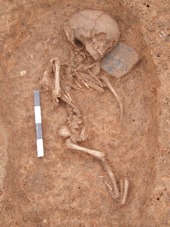Anglo-Saxon skeletons have been surfacing for almost a century
in the fields of Oakington. Now a new project has laid bare the trials
and tragedies of a small 6th-century Fenland community. Duncan Sayer, Richard Mortimer and Faye Simpson bring flesh to the bones.
In 1926 four early Anglo-Saxon burials, one equipped with a spear,
knife and shield boss, were discovered in an Oakington village field, in
Cambridgeshire. Described as ‘[south] of the church’, the land had just
been bought by Alan Bloom for his nursery garden. His interest piqued,
Alan dug dozens more holes, only abandoning the hunt for further bodies
when he hit undisturbed subsoil. Yet there were more to find.
Construction of a children’s playground in the 1990s brought 26 burials
to light, excavated by Cambridgeshire’s Archaeological Field Unit, while
2006 and 2007 saw Oxford Archaeology East recover 17 more. In 2010 and
2011 students and researchers returned to the site, opening new trenches
on either side of the playground and revealing 27 further burials –
including a pregnant woman, a warrior and, most exceptional of all, a
large number of child burials from a period when they are notoriously
scarce.
With several seasons left to go, Oakington is fully established as a substantial 6th-century Anglo-Saxon cemetery. But
there is more to the site than that. Capitalising on the longer view
that a research and community project provides, test pits and whole
trenches have been excavated in gardens and open spaces throughout the
village. The tantalising results point to an early enclosed community – a
Middle Saxon Burh – on the edge of the Cambridgeshire Fen.

